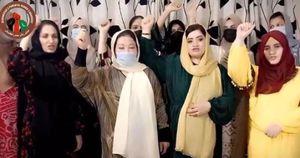Israel’s intensified military operations aimed at northern Gaza are leading to severe humanitarian crises and mass displacements among Palestinian residents. Reports indicate the country’s forces have executed at least 22 strikes as it pushes forward with its incursion, particularly focusing on towns like Beit Hanoun. Residents have described how Israeli forces have besieged shelters housing displaced families, ordering the few remaining residents to leave the area altogether.
According to various reports, the Israeli military appears to be implementing tactics reminiscent of ethnic cleansing, with over 43,500 Palestinians already reported killed since the conflict escalated, primarily women and children. The situation has grown so dire as men have been held for questioning, preventing them from fleeing with women and children toward Gaza City.
A particularly alarming fear among residents is the Israeli government's rumored intentions to re-establish Jewish settlements within the evacuated southern parts. Despite Prime Minister Benjamin Netanyahu's assurance against reversing the 2005 withdrawal of settlers from Gaza, hardline factions within his government are stirring concerns about their plans for repopulating these areas.
According to local residents, the perception is clear: the Israeli government aims to create buffer zones through displacement, thereby paving the way for returning settlers. One shocked resident expressed through messaging apps, "The scenes of the 1948 catastrophe are being repeated. Israel is repeating its massacres, displacement, and destruction."
The humanitarian impact has been overwhelming. A United Nations report highlighted the staggering reality: international aid has faced significant roadblocks, with 85% of humanitarian requests having been blocked or delayed by Israeli authorities. Access to food, shelter, and medical supplies is becoming increasingly restricted, leading to dire ramifications for hundreds of thousands of displaced civilians.
Conditions are exacerbated daily, with staggering statistics showing rampant malnutrition and lack of medical supplies across the region. Israel's military actions are not only creating physical barriers but are also disrupting the civilian life of those left behind, leading to growing frustration and despair among the populace.
Areas like Jabalia, once vibrant neighborhoods filled with families, are now ghost towns, reducing vast stretches of Gaza to rubble. Survivors are struggling to find refuge, as even makeshift shelters are targeted. Families now live under constant threats of airstrikes and ground incursions, as conditions worsen. Streets where children once played have become treacherous battlefields, littered with debris and destruction.
Further complicity lies with the narratives surrounding the situation, as Israeli defense officials often refer to their tactics as “cutting the grass.” This euphemistic language downplays the violence and suffering experienced on the ground, insinuates the regularity of military incursions to suppress any potential resurgence of Hamas, complicates peace efforts, and heightens civilian fears.
It appears there’s little indication from the Israeli government about what postconflict stabilization might look like, allowing Hamas to regain footholds amid the continuously chaotic atmosphere. Conflicts between military necessity and humanitarian responsibilities continue to abound, with extensive discussions about whether Israel can maintain its military presence without providing adequate care for displaced Palestinians.
The comprehensive nature of this military movement is imbued with serious geopolitical ramifications, particularly as humanitarian aid efforts remain strangled. Even as world organizations push for answers and immediate reprieve, the Israeli military's action continues unabated.
Global response has been tepid, with many nations caught between condemning the violence and supporting Israel’s right to defense. This geopolitical quagmire traps Palestinians between warring factions with divergent goals and few advocates. The longer-term impact of the Israeli strategy might shape the Middle East for decades to come, embedding conflicts of sovereignty and territory deep within the region's fabric.
While the U.N. warns of impending famine conditions, many practical barriers impede any immediate solution or shift toward peace and stability. This dire reality paints a grim picture of life for every civilian caught up within this violence—today and for generations to come.
With clashes continuing to be reported daily and international aid efforts stifled, the question remains: will the world’s community intervene effectively, or will standing by fuel the escalation of violence and suffering?



